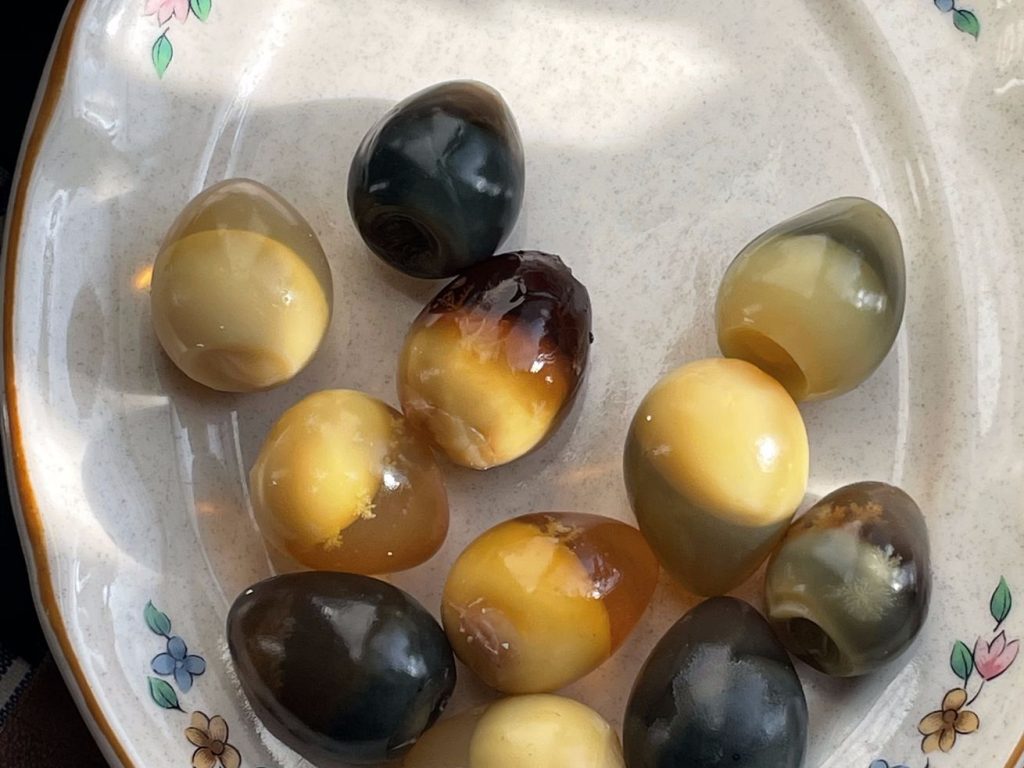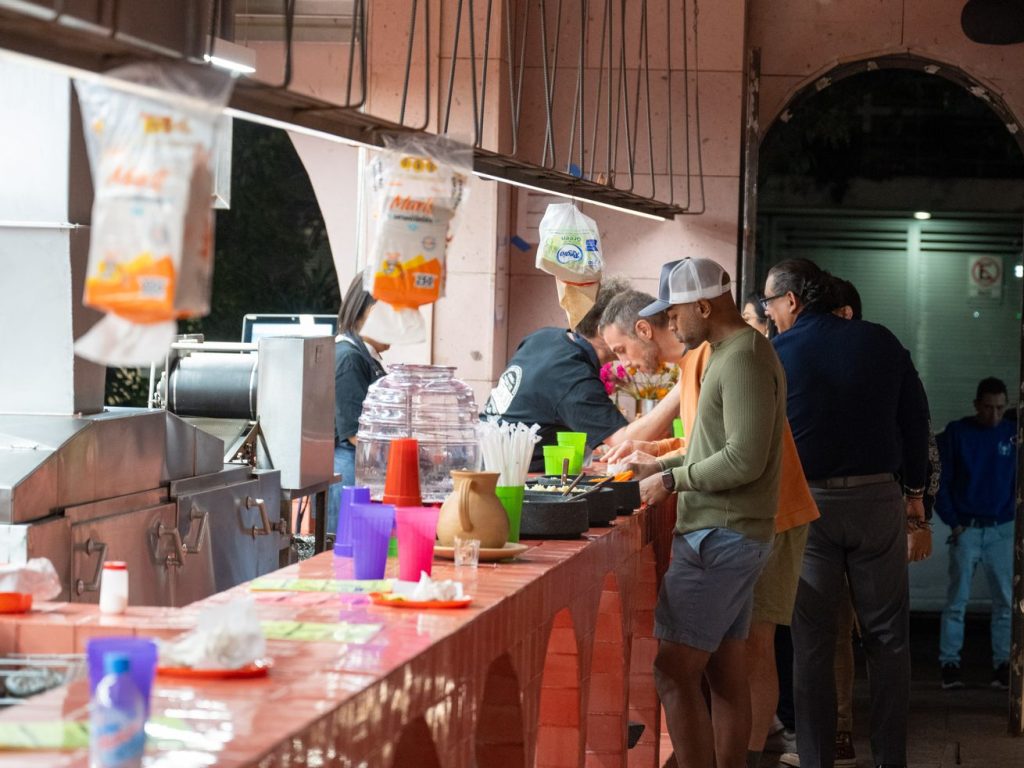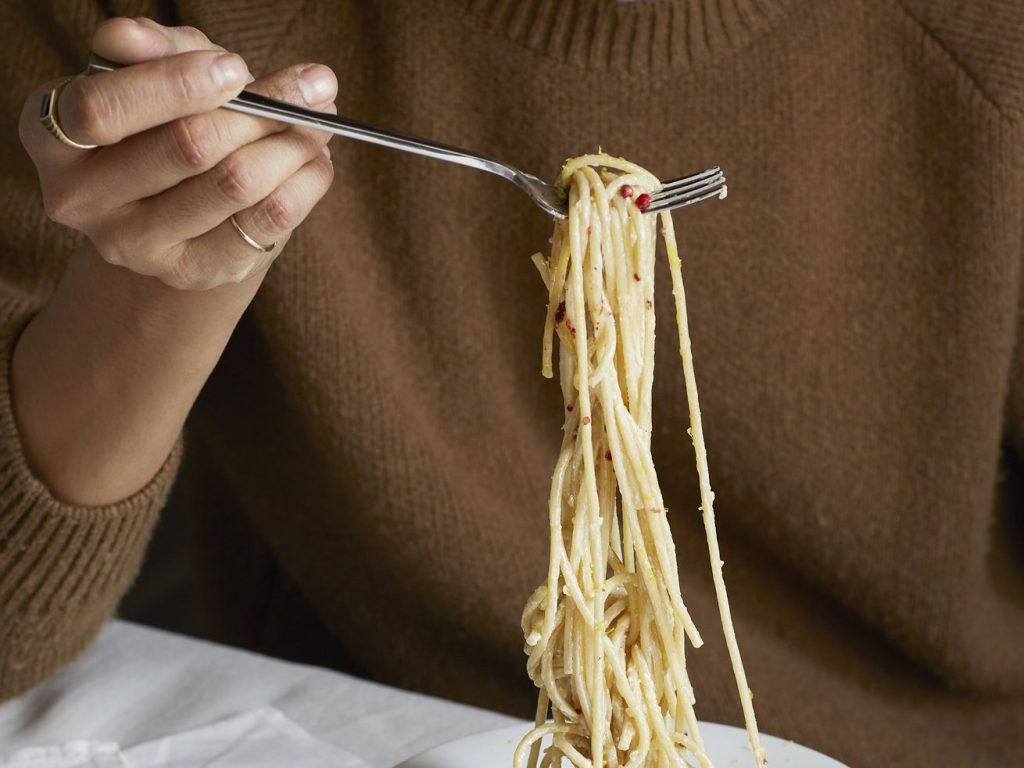Jess Eng
Bouncy, pungent, and creamy, century eggs are everyday staple in China — and contrary to their name, don’t take that long to make
I can’t pinpoint my first experience with century eggs, but I’ve been consuming them my whole life. Bouncy, black, and semi-transparent, they are a reliable addition to congee, rice bowls, and stir-fries, and I often crave their pungent, creamy flavors. I always took their name at face value, believing they were created eons ago, perhaps before our country existed; I was captivated by the egg’s gripping, seemingly irrefutable lore. But that illusion shattered a few months ago, when I learned that century eggs take no more than two months, not hundreds of years, to form.
Century eggs go by many names — preserved eggs, alkalized eggs, pi dan, bian dian, or even a thousand-year-old egg — but at their core, they are simply cured eggs. Eggs of all sizes can be cured in this style, the most popular being duck and quail, and produce a spectrum of textures, colors, and flavors. When halved, century eggs look similar to banded gemstones, except with gelatinous, squishy “whites” and rich creamy “yolks.” With a hint of minerality and sulfur, and a taste reminiscent of blue cheese, century eggs are the secret ingredient in my favorite dishes.
Considered more of an everyday staple than a luxury, century eggs are consumed all over China, Hong Kong, and parts of southeast Asia. Xueci Cheng, a recipe developer who grew up in Chengdu, Sichuan, prefers them in a cold appetizer, whether splashed with chile oil and black vinegar or mixed with tofu and green peppers. They also show up in classic dishes: Cantonese century egg and pork congee, Hunanese lei laojiao or smashed chiles with century egg and eggplant, and Thai basil stir-fries. At more avant garde restaurants, chefs might even shape the bouncy eggs into jiggly cubes or smear slices with seasonal fruit jam, as if they were blue cheese.
Hundreds of recipes incorporate century eggs into both traditional and inventive dishes, many of which I’ve made at home. Few recipes in English, however, show the meticulous process of crafting the perfect egg from scratch. I recently stumbled upon videos that showcase the egg’s production with traditional ingredients like ash, quicklime, clay, and rice hulls. But what home cook has a pound of ash lying around?
I never imagined making them myself until I found chef Corey Lee’s six-ingredient thousand-year-old egg recipe in Benu. I also sought advice from others who have successfully made century eggs: Thomas Etheve, a former Benu line cook and current kitchen manager at San Francisco’s San Ho Won, and Polly Yim, the founder of the Berlin-based Qu Fermentation Studio. With the assurance that I need not wait a thousand years to see results, and an airtight, abbreviated recipe from a three-star Michelin kitchen, I finally felt emboldened to try this recipe at home.
The first part of making century eggs is to cultivate a powerful, pungent brine. Just four ingredients will do the trick: lye or sodium hydroxide, zinc oxide, salt, and water. In lieu of quickline and ash, this strong alkaline combination raises the pH of the egg and helps denaturize its proteins. (Essentially, the clear egg whites will firm up and darken in color.) Don’t fret if these ingredients sound too scientific. With just a few calls and web searches, I easily procured sodium hydroxide from a nearby spice shop and food grade zinc oxide from an online retailer. Here, Yim recommends starting with quail eggs, rather than larger duck or chicken eggs, for more consistent results. Adding dried tangerine peels, cinnamon, or earthy pu’erh tea can enhance the brine even more but these ingredients are not essential.
I quickly understood that making century eggs from scratch was not a beginner project. From the start, you’ll be handling corrosive ingredients, such as lye, so I highly recommend using gloves and a protective face mask or glasses. The process also extends over several weeks, though it’s mostly downtime. It begins simply enough: First, you boil a pot of water and steep any spices or tea leaves before straining. (I added pu’erh, following Etheve’s advice.) Then, you combine the mix with cold water and precise measurements of sodium hydroxide and zinc in a sanitized jar. The next day, I placed the quail eggs in the brine and stored the jar away from sunlight for 12 days.
After that initial period, I was ready to cure my eggs. With gloves and a sanitized spoon, I removed the eggs from the brine, gently rinsed excess liquid from the shells, and let them sun-dry for an hour. While it’s totally optional, you can cover the eggs in molding clay and roll it in rice hulls or hay to replicate the traditional curing process. (Go on and dig a mud pit while you’re at it, too.) Or do as I did: Seal the eggs in a plastic bag and enclose the bag in an airtight container to prevent exposure to oxygen. Admire your eggs for a second because you’ll be saying goodbye for the next five weeks. I found a cool, dry, dark spot in a cabinet so the eggs could cure in peace.
Once five weeks were up, my cravings for homemade century eggs reached a zenith. I strapped on a protective mask and gloves, cracked open a window, and sanitized my surfaces. I gently dropped four eggs into a pot of boiling water for one minute to sanitize the shells and transferred the finished ones to an ice bath. (Avoid adding all the eggs at once, since the water may overboil at points and release foul vapors). Now, you can decide to peel them or wait. Peeled eggs can be consumed immediately, or sit in the fridge for three days. But an unpeeled, cooked century egg can hypothetically last in the fridge forever. After all, these eggs are now cured.
There’s a few telltale signs of a delicious century egg. Cheng prefers hers with jammy insides and springy exteriors. In particular, she’s fond of golden century eggs with visually appealing layers and a smoother, milder taste. Eggs with pine flowers, the spindly snowflake-like crystals that form along the surface, are also highly prized and the result of alkalinized amino acids.
Century eggs can also vary in color depending on the process. “Being able to vacuum seal the eggs during the curing process is also really important for the development of the dark color,” Yim says. “Traditionally they are encased in a mixture of ash, clay, and rice bran to create a near-anaerobic environment. The presence of oxygen during curing will lead to a more golden egg white rather than black.”
Because of the high alkalinity, all century eggs will have a distinct sulfuric smell, akin to ammonia. While it may be initially off-putting, a faint odor is actually a positive sign. “A good century egg has a hit of ammonia when you open the egg,” Yim explains. “If the egg is missing the ammonia scent, it hasn’t been prepared or stored properly as ammonia is extremely volatile and will dissipate quickly into the air.” That being said, you should strongly avoid and potentially toss any eggs with an extremely pungent ammonia smell.
After my home experiments, I wondered how a three-star Michelin restaurant kitchen like Benu could consistently churn out century eggs for a tasting menu. When he joined the kitchen in 2013, Etheve recalls preparing century eggs for 500 guests every week. As the first course of the meal, painstaking preparation was paramount. A single quail egg, made from locally sourced eggs and high-quality pu’erh, was frequently paired with pickled ginger and cabbage potage to balance its pungent, sulfuric notes. It was impossible, at least in this context, to compare homemade century eggs to store-bought ones: “It’s like making your own french fries with organic potatoes and frying it in duck fat, and then having McDonalds,” Etheve says.
Admittedly, store-bought eggs have one benefit: consistency. In the aisle of your favorite Chinese grocery, century eggs offer predictable colors and gorgeous pine flowers. But die-hard home cooks can still find joy in the project’s roulette-like suspense. “Homemade ones will vary much more in the strength of the alkalinization and textures,” Yim says. “Every egg will be a bit of a mystery until you open it.”
Like Yim, I relished the tactile experience of cracking each shell and peeling back the layers, always hoping to spot elusive pine flowers. More than once, I had to resist peeling all the eggs, knowing that unopened ones could be stored indefinitely in the fridge. Some emerged stunningly golden, others took on a greyish-green marbling, and a few lucky ones bore delicate crystalline patterns. One, however, was nothing more than a brittle, empty shell.
Would I make century eggs again? Maybe, if I miraculously found spare time and enthusiastic friends to share them with. But I’m not in a rush to make my next batch, especially since I can purchase beautiful century eggs whenever the craving strikes. In the meantime, I celebrated my homemade batch with a quick and delicious dinner: wedges of golden and black century eggs atop silken tofu, showered in garlic, cilantro, and soy sauce.



